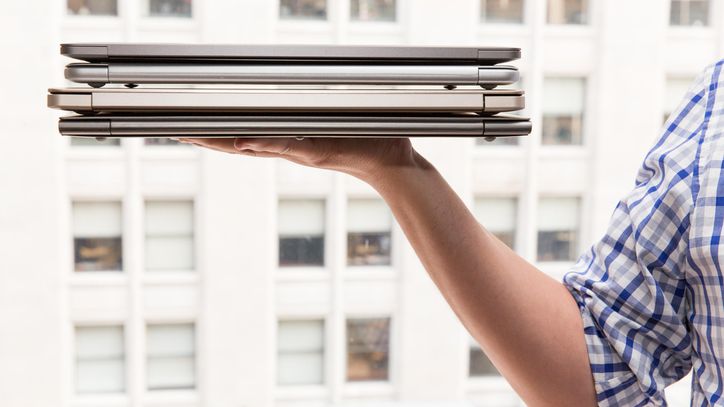These are the lightest 15-inch notesbook you can buy
In the past, if you wanted a lightweight laptop that weighs less than three pounds, you had to find it on a 12 inch or 13 inch screen size. Not anymore.
With display sizes of 15 or 15.6 inches, these ultraportable laptops give you more room for work, viewing the web, movies and games. But, with weights ranging from 2.4 to 4.4 pounds (1.1 to 2 kilograms), you can take them with you on a daily commute or around campus without sore shoulders or a strained back.
Keep in mind, though, you are paying a premium for carrying around less weight: The least expensive laptop here starts at $800 (approximately £600 or AU$1,000). Also, while there are a couple here that offer some beefier performance with discrete graphics, most of them are meant for average day-to-day use like word processing, using web apps and streaming media. That makes them a good choice for work or school where mobility and screen size are more important than high performance.
LG Gram 15
At 2.4 pounds (1.1 kg), the Gram is the lightest 15.6-inch laptop you’ll find at the moment. It also happens to have great battery life, lasting 9 hours and 42 minutes on our streaming video test. The Gram does feel a bit flimsy, but its magnesium alloy body should stand up to some abuse. It’s available with a touchscreen and Core i7 processor for $1,500 (about £1,185, AU$1,990) or with a Core i5 and a non-touch full-HD display for $1,200 (about £920, AU$1,510).
Samsung Notebook 9
The Notebook 9’s 15-inch display is slightly smaller than the Gram’s, but it improves on the LG in almost every other way and weighs only ounces more at 2.6 pounds or 1.2 kg. Its battery life is stellar at more than 12 hours — one of the longest we’ve tested. The Notebook 9 starts at $1,250 (roughly £960, AU$1,575), but if you’re willing to pay $1,400 (roughly £1,075 or AU$1,765), you can get it with an Nvidia GeForce 940MX graphics card to assist with photo editing or do some gaming with the settings dialed back.
Asus VivoBook S15
At 3.6 pounds (1.6 kg), the VivoBook is noticeably heavier than the LG or Samsung. However, it also starts at $800 (about £600 or AU$1,000) and features the same dual-core 2.7GHz Intel Core i7-7500U processor found in those models.
Asus also ups the storage by including two drives: A solid-state drive for fast boot times and application performance, and a slower, but significantly larger hard drive for storage.
There is a Windows 10 Signature Edition that upgrades the integrated graphics to a discrete Nvidia 940MX GPU. The biggest disappointment is its Asus a32-k52 laptop battery, which hit only 7 hours and 7 minutes on our video streaming test.
Samsung Notebook 9 Pro
The Notebook 9 Pro weighs the same as the VivoBook, 3.6 pounds (1.6 kg), but does considerably more for its $1,299 (roughly £1,075 or AU$1,765) price. It’s a 2-in-1 for starters, with a 360-degree hinge so you can flip its 1,920×1,080-resolution touchscreen into multiple positions.
It’s also Samsung’s first notebook to include a built-in S Pen with 4,000 pressure levels for writing and drawing on the screen. Samsung even put in an AMD Radeon 540 graphics card in it that’s good enough for a little low-setting gaming and image work.
Apple MacBook Pro
The top of Apple’s lineup and the king of high-end laptops, the 15.4-inch model weighs only 4 pounds (1.8 kg), but is the most powerful system in this roundup. It’s the most expensive, too, starting at $2,400 (£2,350 or AU$3,500).
True, having only USB-C ports is a bit of a hassle, and the superflat keyboard requires some adjustment, but the excellent Retina-resolution display, the bigger touchpad and even the second-screen Touch Bar keep things interesting. Plus, the battery life is long at 10 hours and 43 minutes.
Dell XPS 15
The XPS 15 can match the weight and performance of the MacBook Pro while instead running, you know, Windows 10. Featuring 7th-gen Core i3, i5 or i7 processors, the entry model with a dual-core i3, a 1,920×1,080-pixel resolution display and integrated graphics starts at $999 (which appears to be a US-only model, but would roughly convert to £765 and AU$1,260) and weighs 4 pounds (1.8 kg). A different starter model in the UK begins at £1,399, while the one for Australia begins at AU$2,499.
If you don’t mind an extra half pound (and about $800 more), you can get it with an accurate 4K-resolution touchscreen with hardware calibration support, 100 percent Adobe RGB and most of the DCI-P3 coverage and an Nvidia GeForce GTX 1050 graphics card to push those pixels around. A similarly equipped model also runs for £1,849 and AU$2,699.
HP Spectre x360
When we reviewed the 15.6-inch Spectre x360, we may have complained that this premium 2-in-1 wasn’t particularly lightweight. (What can I say? We’re spoiled.) Weighing in at 4.4 pounds (2 kg), it’s about as heavy as the Dell XPS 15, but can be used as a pen-enabled tablet just as easily as a laptop.
For $1,500 (£1,500 or roughly converting to AU$1,670), it’s an all-around good performer, too, with nearly 10 hours of HP pavilion dv6 battery life in our tests. Plus, it just looks really nice.
Did you enjoy this post? Why not leave a comment below and continue the conversation, or subscribe to my feed and get articles like this delivered automatically to your feed reader.


Comments
No comments yet.
Sorry, the comment form is closed at this time.